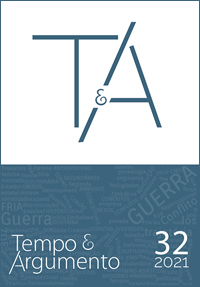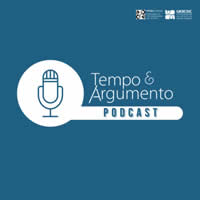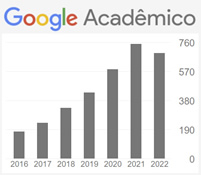Quando o mal é grande e sem remédio radical, tomamos remédios improvisados – a industrialização do cinema e as origens da organização do público na França (1895-1914)
DOI:
https://doi.org/10.5965/2175180313322021e0203Resumen
A expansão mundial da sala de cinema comercial entre os anos de 1908 e 1914 foi notável, e incontestável. Neste artigo, procuramos demonstrar que essa expansão, ou industrialização do cinema, desenvolveu-se em lógica empresarial que buscava explorar ao máximo a reprodutibilidade do filme e a multiplicação do número de espectadores. Surgiu, daí, a primeira ideia de público de cinema. A formação desse público passou, ainda, pela naturalização do modo de representação do cinema clássico, com seus temas e formatos que instituíram a passividade nos indivíduos diante dos filmes. Entretanto, a posição do movimento operário francês do começo do século XX, diante do cinematógrafo, demonstra que a criação desse modo de representação não foi sentida passivamente. A convivência social dos operários nos primeiros anos de existência do cinema apresentou outra forma de relação com a imagem em movimento, diversa da comercial, apontando na categoria de “público” uma escala de análise na história contemporânea alternativa às noções consagradas de “massa” ou “espectador”.
Descargas
Citas
ADORNO, T. W.; HORKHEIMER, Max. Dialética do esclarecimento: fragmentos filosóficos. Rio de Janeiro: Jorge Zahar Ed., 1985.
ALTENLOH, Emilie. Pour une sociologie du cinéma (1914). In: BANDA, Daniel; MOURE, José. Le cinema: naissance d’un art – 1895-1920. Paris: Éditions Flammarion, 2008.
ARCHIVES NATIONALES. AN F715954/1: direction de la surete generale: dossier Sebástien Faure. Pierrefite-sur-Seine, [19--]. Série F/7 Police Générale.
DE AMICIS, Edmondo. Cinématographe Cérébral. In: BANDA, Daniel; MOURE, José. Le cinema: naissance d’un art – 1895-1920. Paris: Éditions Flammarion, 2008.
BANDA, Daniel; MOURE, José. Le cinema: naissance d’un art: 1895-1920. Paris: Éditions Flammarion, 2008.
BRENEZ, Nicole. O cinema e o “uso das representações”. In: MARINONE, Isabelle. Cinema e anarquia: uma história “obscura” do cinema na França (1895-1935). Rio de Janeiro: Azougue Editorial, 2009.
BURCH, Noel. La lucarne de l’infini: naissance du langage cinématographique. Paris: L’Harmattan, 2007.
COSTA, Flávia Cesarino. Primeiro Cinema. In: MASCARELLO, Fernando (org.). História do cinema mundial. Campinas: Papirus, 2006. p. 17-52.
DAUTHUILLE, A. En Champagne – Cinéma-Police. Le Libertaire, Paris, 29 abr. 1911.
DUREAU, Georges. Le Cinématographe et la Police. Ciné-Journal, Paris, p. 3, 21 janvier 1911.
ESQUENAZI, Jean-Pierre. Sociologia dos públicos. Porto: Porto Editora, 2006.
FAIT divers: films patriotiques. La Bataille Syndicaliste, Paris, 22 fevrier 1914.
GRAVE, Jean. La Société mourante ou l’anarchie. Paris: Tresse & Stock Éditeurs, 1893.
GUICHARD, E. Au Cinéma. Le Libertaire, Paris, 27 mai 1911.
HERZOG, Charlotte. The movie palace and the theatrical sources of its architectural style. In: HARK, Ina Rae (org.). Exhibition, the film reader. Londres: Routledge, 2002.
LAURENT, E.; LEPINE. Extrait de l’ordonnance de Police Concernant les Theatres (Cinématographes). Paris, le 10 Août 1908. In: Cinéma: Annuaire de la projection fixe et animée. Paris, Charles-Mendel Editeur, p. 52, 1911.
LE PUBLIC et le cinema. La Bataille Syndicaliste, Paris, 04 mars 1913.
LEVI, Giovanni. Comportamentos, recursos, processos: antes da “revolução” do consumo. In: REVEL, Jacques (org.). Jogos de escalas: a experiência da micro-análise. Rio de Janeiro: Fundação Getúlio Vargas Editora, 1998. p. 203-224.
MACEDO, Felipe. Cinéma du Peuple, le premier cinéclub. The cineclub’s review: n. 1. Marília: Editora Praxis, 2010.
MARINONE, Isabelle. Cinema e anarquia: uma história “obscura” do cinema na França (1895-1935). Rio de Janeiro: Azougue Editorial, 2009.
MARTINET, Marcel. Le cinema nécessaire. La bataille Syndicaliste, Paris, 09 mars 1913.
MAUERHOFER, Hugo. A psicologia da experiência cinematográfica. In: XAVIER, Ismail (org.). A experiência do cinema. Rio de Janeiro: Graal, 1983.
MCDONALD, D. Association Bulletin n. 14. Executive Committee meeting. In: Views and film index. New York: Films Publishing Co, n. 106, May 2, p. 5, 1908.
MENOTTI, Gabriel. Arquitetura da espectação: a construção histórica da situação cinema nos espaços de exibição cinematográfica. Revista Eletrônica do Programa de Pós-Graduação em Comunicação da Universidade Federal Fluminense, Rio de Janeiro, Ano 9, n. 18, p. 1-12, jul. 2007.
MERCIER, Lucien. Les universites populaires: 1899-1914: éducation populaire et mouvement ouvrier au début du siècle. Préface de Madeleine Rebérioux. Paris: Collection Mouvement Social; Les Éditions Ouvrières, 1986.
MORETTIN, Eduardo V. O cinema como fonte histórica na obra de Marc Ferro. In: CAPELATO, Maria Helena et al. História e cinema: dimensões históricas do audiovisual. 1 ed. São Paulo: Alameda Casa Editorial, 2007. p. 39-64.
MUNDIM, Luiz Felipe C. As marchas de Gustave Cauvin: a primeira forma sistematizada e regular do cinema militante. Revista Mundos do Trabalho, [S.l.], v.9, p. 83-98, 2018.
MUSSER, Charles. L’industrie du cinema em France et aux États Unis entre 1900 et 1920: l’évolution du mode de production. In: BENGHOZI, Pierre-Jean; DELAGE, Christian. Une histoire économique du cinéma français: 1895-1995: regards franco-américains. [Paris]: L’Harmattan, 1997. p. 63-80.
NORRIS, Frank. McTeague: a story of San Francisco. New York: Double Day & Company, 1904.
PERRON, Tangui. Le contrepoison est entre vos mains, camarades’: C.G.T. et cinéma au début du siècle. Le Mouvement Sociale, Paris: Éditions de l’atelier, n. 172, p. 21-36, juil./sept. 1995.
RANNEY, H. M. Account of the terrific and fatal riot at the New-York Astor Place Opera House: on the night of May 10th, 1849. New-York: H. M. RANNEY, 1849.
REVEL, Jacques. A história ao rés-do-chão. In: LEVI, Giovanni. A herança imaterial: trajetória de um exorcista no Piemonte do século XVII. Rio de Janeiro: Civilização Brasileira, 2000. p. 7-37.
SCHWARTZ, Vanessa. O espectador cinematográfico antes do aparato do cinema: o gosto do público pela realidade na Paris fim-de-século. In: CHARNEY, Leo; SCHWARTZ, Vanessa R. (org.) O cinema e a invenção da vida moderna. São Paulo: Cosac & Naify, 2001. p. 411-440.
WHAT PATHÉS visit means. In: Views and film index. New York: Films Publishing Co, n. 106, May 2, p. 3, 1908.
YOUNG, Paul. Telling descriptions: Frank Norris’s kinetoscopic naturalism and the future of the novel, 1899. In: MODERNISM / MODERNITY. [Baltimore]: The Johns Hopkins University Press, 2007. v. 14. p 645–668.
Descargas
Publicado
Cómo citar
Número
Sección
Licencia
Derechos de autor 2021 Revista Tempo e Argumento

Esta obra está bajo una licencia internacional Creative Commons Atribución-NoComercial 4.0.
Os artigos cujos autores são identificados representam a expressão do ponto de vista de seus autores e não a posição oficial da Tempo e Argumento.





